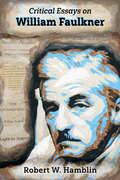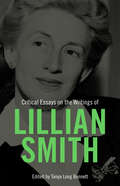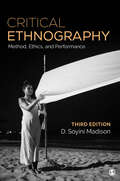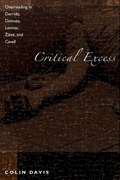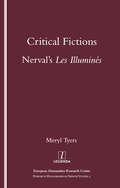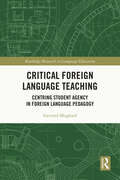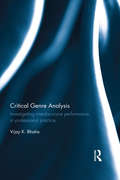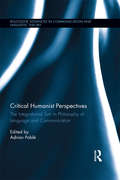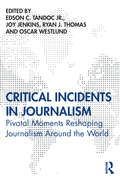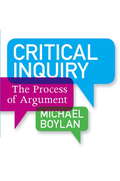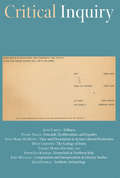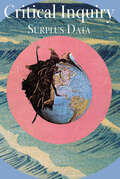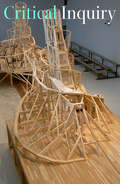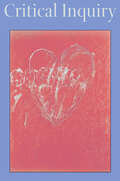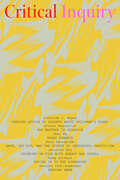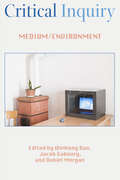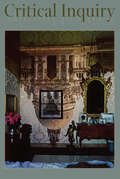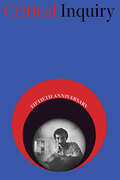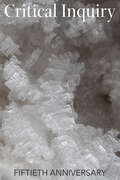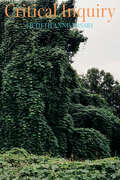- Table View
- List View
Critical Essays on William Faulkner
by Robert W. HamblinCritical Essays on William Faulkner compiles scholarship by noted Faulkner studies scholar Robert W. Hamblin. Ranging from 1980 to 2020, the twenty-one essays present a variety of approaches to Faulkner’s work. While acknowledging Faulkner as the quintessential southern writer—particularly in his treatment of race—the essays examine his work in relation to American and even international contexts. The volume includes discussions of Faulkner’s techniques and the psychological underpinnings of both the origin and the form of his art; explores how his writing is a means of “saying 'no' to death"; examines the intertextual linkages of his fiction with that of other writers like Shakespeare, Twain, Steinbeck, Warren, and Salinger; treats Faulkner’s use of myth and his fondness for the initiation motif; and argues that Faulkner’s film work in Hollywood is much better and of far greater value than most scholars have acknowledged. Taken as a whole, Hamblin’s essays suggest that Faulkner’s overarching themes relate to time and consequent change. The history of Faulkner’s Yoknapatawpha stretches from the arrival of the white settlers on the Mississippi frontier in the early 1800s to the beginnings of the civil rights movement in the 1940s. Caught in this world of continual change that produces a great degree of uncertainty and ambivalence, the Faulkner character (and reader) must weigh the traditions of the past with the demands of the present and the future. As Faulkner acknowledges, this process of discovery and growth is a difficult and sometimes painful one; yet, as Hamblin attests, to engage in that quest is to realize the very essence of what it means to be human.
Critical Essays on William Faulkner: The Sartoris Family
by Arthur F. KinneyStressing the novels Flags in the Dust and Sartoris.
Critical Essays on William Wordsworth
by George H. GiltinOne of a series called Critical Essays on English Literature.
Critical Essays on the Writings of Lillian Smith
by Tanya Long BennettContributions by Tanya Long Bennett, David Brauer, Cameron Williams Crawford, Emily Pierce Cummins, April Conley Kilinski, Justin Mellette, and Wendy Kurant Rollins As a white woman of means living in segregated Georgia in the first half of the twentieth century, Lillian Smith (1897–1966) surprised readers with stories of mixed-race love affairs, mob attacks on “outsiders,” and young female campers exploring their sexuality. Critical Essays on the Writings of Lillian Smith tracks the evolution of Smith from a young girls’ camp director into a courageous artist who could examine controversial topics frankly and critically while preserving a lifelong connection to the north Georgia mountains and people. She did not pull punches in her portrayals of the South and refused to obsess on an idealized past. Smith took seriously the artist’s role as she saw it—to lead readers toward a better understanding of themselves and a more fulfilling existence. Smith’s perspective cut straight to the core of the neurotic behaviors she observed and participated in. To draw readers into her exploration of those behaviors, she created compelling stories, using carefully chosen literary techniques in powerful ways. With words as her medium, she drew maps of her fictionalized southern places, revealing literally and metaphorically society’s disfunctions. Through carefully crafted points of view, she offers readers an intimate glimpse into her own childhood as well as the psychological traumas that all southerners experience and help to perpetuate. Comprised of seven essays by contemporary Smith scholars, this volume explores these fascinating aspects of Smith’s writings in an attempt to fill in the picture of this charismatic figure, whose work not only was influential in her time but also is profoundly relevant to ours.
Critical Ethnography: Method, Ethics, and Performance
by D. Soyini Madison"Critical Ethnography is a rare and beautiful synthesis of deft theorizing and principled pragmatics. The complexities of ethnography demand a grasp of both theory and practice, but rarely have they come together so clearly and completely as in this passionately written text. I especially appreciate the thoughtful attention to the intellectual roots of the critical tradition in ethnography, and to the way students are rigorously led through the methodological consequences of critical epistemology." —Judith Hamera, Texas A&M University "I would strongly recommend this book for use in any course that explores the role of critical analysis in research. This book thoughtfully discusses and teaches about trying to understand the meanings attributed by others in regard to their expertise." —Amy Paul-Ward, Florida International University What is critical ethnography? How do we use theory to interpret research data? What is performance ethnography? Readers can find answers to these fundamental questions in D. Soyini Madison′s engaging and highly multidisciplinary Third Edition of Critical Ethnography: Methods, Ethics, and Performance. The book presents a fresh new look at critical ethnography by emphasizing the significance of ethics and performance in the art and politics of fieldwork. The productive links between theory and method are celebrated in this title. Theoretical concepts range from queer theory, feminist theory, and critical race theory to Marxism and phenomenology. The methodological techniques range from designing and asking in-depth interview questions and developing rapport to coding and interpreting data. The various theories and methods culminate in three fictional ethnographic case studies that "enact" the interdependence between theory and method and the significance of social theory, ethics, and performance.
Critical Ethnography: Method, Ethics, and Performance
by D. Soyini Madison"Critical Ethnography is a rare and beautiful synthesis of deft theorizing and principled pragmatics. The complexities of ethnography demand a grasp of both theory and practice, but rarely have they come together so clearly and completely as in this passionately written text. I especially appreciate the thoughtful attention to the intellectual roots of the critical tradition in ethnography, and to the way students are rigorously led through the methodological consequences of critical epistemology." —Judith Hamera, Texas A&M University "I would strongly recommend this book for use in any course that explores the role of critical analysis in research. This book thoughtfully discusses and teaches about trying to understand the meanings attributed by others in regard to their expertise." —Amy Paul-Ward, Florida International University What is critical ethnography? How do we use theory to interpret research data? What is performance ethnography? Readers can find answers to these fundamental questions in D. Soyini Madison′s engaging and highly multidisciplinary Third Edition of Critical Ethnography: Methods, Ethics, and Performance. The book presents a fresh new look at critical ethnography by emphasizing the significance of ethics and performance in the art and politics of fieldwork. The productive links between theory and method are celebrated in this title. Theoretical concepts range from queer theory, feminist theory, and critical race theory to Marxism and phenomenology. The methodological techniques range from designing and asking in-depth interview questions and developing rapport to coding and interpreting data. The various theories and methods culminate in three fictional ethnographic case studies that "enact" the interdependence between theory and method and the significance of social theory, ethics, and performance.
Critical Excess: Overreading in Derrida, Deleuze, Levinas, Žižek and Cavell
by Colin DavisDrawing on his course "Philosophy, Literature, and Film" and lecture on "In Praise of Overreading," Davis (French, U. of London) defines overreading as testing the hermeneutic constraints limiting the possible interpretations of a text. Following an overview of the contributions of Derrida, Zizak, and Cavell to the philosophical interpretation of film, he explores arguments against/beyond interpretation, e. g. , Deleuze's claim that he was creating something new in reading the arts. Annotation ©2011 Book News, Inc. , Portland, OR (booknews. com)
Critical Fictions: Nerval's "Les Illumines"
by Meryl Tyers"Nerval's ""Les Illumines"" (1852) has often been seen as a problem text, and as a strange supplement to his masterpieces ""Les Chimeres"", ""Les Filles du feu"", and ""Aurelia"". In this first book-length study, in English or French, of ""Les Illumines"", Meryl Tyers argues that it is a complex work of art in its own right and that its originality has been obscured by the tangled publishing history of its individual narratives. Tyers re-examines that history and provides a complete documentary basis for critical discussion of the work. She also traces the critical response from the earliest reviews through to the scholarly editions and studies of the present day. Tyers's own critical reading pays particular attention to 'La Bibliotheque de mon oncle', Nerval's intriguing preface. By investigating in detail those fragmentary structures and varying themes that may at first make the unity of ""Les Illumines"" seem elusive, she is able to show that subtle integrative mechanisms are at work in a volume that deserves to be placed among the highest achievements of this incomparable poet."
Critical Foreign Language Teaching: Centring Student Agency in Foreign Language Pedagogy (Routledge Research in Language Education)
by Gerrard MugfordThis book develops the theory and practice of critical foreign language pedagogy. Written by a distinguished scholar of pragmatics and sociolinguistics, it encourages educators to think beyond traditional methods of language teaching to consider both the social reality of being a foreign language user and the personal goals and experiences of each learner. It emphasises the need to teach students how to navigate the types of interactional difficulties, power imbalances, and hostility they may experience outside of the classroom as well as how to recognise and analyse ‘native’ speaker norms and practices. It further stresses the importance of first-language knowledge in developing foreign language expertise, encouraging educators to build on the skills learners already have to empower them to express their personality and individuality in their target language.A significant contribution to foreign language pedagogy, this book offers language teachers, bilingual speakers, and researchers practicable insights into how to support learners to attain and realise their own goals and aspirations in their target language.
Critical Genre Analysis: Investigating interdiscursive performance in professional practice
by Vijay K. BhatiaGenre theory has focused primarily on the analysis of generic constructs, with increasing attention to and emphasis on the contexts in which such genres are produced, interpreted, and used to achieve objectives, often giving the impression as if producing genres is an end in itself, rather than a means to an end. The result of this focus is that there has been very little attention paid to the ultimate outcomes of these genre-based discursive activities, which are more appropriately viewed as academic, institutional, organizational, and professional actions and practices, which are invariably non-discursive, though often achieved through discursive means. It was this objective in mind that the book develops an approach to a more critical and deeper understanding of interdiscursive professional voices and actions. Critical Genre Analysis as a theory of discursive performance is thus an attempt to be as objective as possible, rigorous in analytical endeavour, using a multiperspective and multidimensional methodological framework taking into account interdiscursive aspects of genre construction to make it increasingly explanatory to demystify discursive performance in a range of professional contexts.
Critical Humanist Perspectives: The Integrational Turn in Philosophy of Language and Communication (Routledge Advances in Communication and Linguistic Theory)
by Adrian PabléThe present book is a collection of scholarly reflections on the theme of humanism from an integrational linguistic perspective. It studies humanist thought in relation to the philosophy of language and communication underpinning it and considers the question whether being a ‘humanist’ binds one to a particular view of language. The contributions to this volume explore whether integrational linguistics, being informed by a non-mainstream semiology and adopting a lay linguistic perspective, can provide better answers to contentious ontological and epistemological questions concerning the humanist project – questions having to do with the self, reason, authenticity, creativity, free agency, knowledge and human communication. The humanist perspectives adopted by the contributors to this volume are critical insofar as they start from semiological assumptions that challenge received notions within mainstream linguistics, such as the belief that languages are fixed-codes of some kind, that communication serves the purpose of thought transfer, and that languages are prerequisites for communication.
Critical Incidents in Journalism: Pivotal Moments Reshaping Journalism around the World
by Oscar Westlund Edson C. Tandoc Jr. Joy Jenkins Ryan J. ThomasThis edited collection examines critical incidents journalists have faced across different media contexts, exploring how journalists and other key actors negotiate various aspects of their work. Ranging from the Rwandan genocide to the News of the World hacking scandal in the UK, this book defines a critical incident as an event that has led journalists to reconsider their routines, roles, and rules. Combining theoretical and practical analysis, the contributors offer a discussion of the key events that journalists cover, such as political turmoil or natural disasters, as well as events that directly involve and affect journalists. Featuring case studies from countries including Australia, Germany, Brazil, Kenya, and the Philippines, the book explores the discourses that critical events have generated, how journalists and other stakeholders have responded to them, and how they have reshaped (or are reshaping) journalistic norms and practices. The book also proposes a roadmap for studying such pivotal moments in journalism. This one-of-a-kind collection is a valuable resource for students and scholars across journalism studies disciplines, from journalism history, to sociology of news, to digital journalism and political communication.
Critical Inquiry
by Michael BoylanA succinct handbook on reading and responding critically to argumentative texts, suitable alike for courses in informal logic and the argumentative/persuasive essay. aa
Critical Inquiry, volume 48 number 1 (Autumn 2021)
by Critical InquiryThis is volume 48 issue 1 of Critical Inquiry. Critical Inquiry is a peer-reviewed interdisciplinary journal devoted to the best critical thought in the arts and humanities. Combining a commitment to rigorous scholarship with a vital concern for dialogue and debate, the journal presents articles by eminent and emerging scholars, critics, and artists on a wide variety of issues in contemporary criticism and culture. Associated with no single school of thought, tied to no single discipline, Critical Inquiry is dedicated to providing a forum for cutting-edge thought while reconsidering traditional concepts and practices.
Critical Inquiry, volume 48 number 2 (Winter 2022)
by Critical InquiryThis is volume 48 issue 2 of Critical Inquiry. Critical Inquiry is a peer-reviewed interdisciplinary journal devoted to the best critical thought in the arts and humanities. Combining a commitment to rigorous scholarship with a vital concern for dialogue and debate, the journal presents articles by eminent and emerging scholars, critics, and artists on a wide variety of issues in contemporary criticism and culture. Associated with no single school of thought, tied to no single discipline, Critical Inquiry is dedicated to providing a forum for cutting-edge thought while reconsidering traditional concepts and practices.
Critical Inquiry, volume 48 number 3 (Spring 2022)
by Critical InquiryThis is volume 48 issue 3 of Critical Inquiry. Critical Inquiry is a peer-reviewed interdisciplinary journal devoted to the best critical thought in the arts and humanities. Combining a commitment to rigorous scholarship with a vital concern for dialogue and debate, the journal presents articles by eminent and emerging scholars, critics, and artists on a wide variety of issues in contemporary criticism and culture. Associated with no single school of thought, tied to no single discipline, Critical Inquiry is dedicated to providing a forum for cutting-edge thought while reconsidering traditional concepts and practices.
Critical Inquiry, volume 48 number 4 (Summer 2022)
by Critical InquiryThis is volume 48 issue 4 of Critical Inquiry. Critical Inquiry is a peer-reviewed interdisciplinary journal devoted to the best critical thought in the arts and humanities. Combining a commitment to rigorous scholarship with a vital concern for dialogue and debate, the journal presents articles by eminent and emerging scholars, critics, and artists on a wide variety of issues in contemporary criticism and culture. Associated with no single school of thought, tied to no single discipline, Critical Inquiry is dedicated to providing a forum for cutting-edge thought while reconsidering traditional concepts and practices.
Critical Inquiry, volume 49 number 1 (Autumn 2022)
by Critical InquiryThis is volume 49 issue 1 of Critical Inquiry. Critical Inquiry is a peer-reviewed interdisciplinary journal devoted to the best critical thought in the arts and humanities. Combining a commitment to rigorous scholarship with a vital concern for dialogue and debate, the journal presents articles by eminent and emerging scholars, critics, and artists on a wide variety of issues in contemporary criticism and culture. Associated with no single school of thought, tied to no single discipline, Critical Inquiry is dedicated to providing a forum for cutting-edge thought while reconsidering traditional concepts and practices.
Critical Inquiry, volume 49 number 2 (Winter 2023)
by Critical InquiryThis is volume 49 issue 2 of Critical Inquiry. Critical Inquiry is a peer-reviewed interdisciplinary journal devoted to the best critical thought in the arts and humanities. Combining a commitment to rigorous scholarship with a vital concern for dialogue and debate, the journal presents articles by eminent and emerging scholars, critics, and artists on a wide variety of issues in contemporary criticism and culture. Associated with no single school of thought, tied to no single discipline, Critical Inquiry is dedicated to providing a forum for cutting-edge thought while reconsidering traditional concepts and practices.
Critical Inquiry, volume 49 number 3 (Spring 2023)
by Critical InquiryThis is volume 49 issue 3 of Critical Inquiry. Critical Inquiry is a peer-reviewed interdisciplinary journal devoted to the best critical thought in the arts and humanities. Combining a commitment to rigorous scholarship with a vital concern for dialogue and debate, the journal presents articles by eminent and emerging scholars, critics, and artists on a wide variety of issues in contemporary criticism and culture. Associated with no single school of thought, tied to no single discipline, Critical Inquiry is dedicated to providing a forum for cutting-edge thought while reconsidering traditional concepts and practices.
Critical Inquiry, volume 49 number 4 (Summer 2023)
by Critical InquiryThis is volume 49 issue 4 of Critical Inquiry. Critical Inquiry is a peer-reviewed interdisciplinary journal devoted to the best critical thought in the arts and humanities. Combining a commitment to rigorous scholarship with a vital concern for dialogue and debate, the journal presents articles by eminent and emerging scholars, critics, and artists on a wide variety of issues in contemporary criticism and culture. Associated with no single school of thought, tied to no single discipline, Critical Inquiry is dedicated to providing a forum for cutting-edge thought while reconsidering traditional concepts and practices.
Critical Inquiry, volume 50 number 1 (Autumn 2023)
by Critical InquiryThis is volume 50 issue 1 of Critical Inquiry. Critical Inquiry is a peer-reviewed interdisciplinary journal devoted to the best critical thought in the arts and humanities. Combining a commitment to rigorous scholarship with a vital concern for dialogue and debate, the journal presents articles by eminent and emerging scholars, critics, and artists on a wide variety of issues in contemporary criticism and culture. Associated with no single school of thought, tied to no single discipline, Critical Inquiry is dedicated to providing a forum for cutting-edge thought while reconsidering traditional concepts and practices.
Critical Inquiry, volume 50 number 2 (Winter 2024)
by Critical InquiryThis is volume 50 issue 2 of Critical Inquiry. Critical Inquiry is a peer-reviewed interdisciplinary journal devoted to the best critical thought in the arts and humanities. Combining a commitment to rigorous scholarship with a vital concern for dialogue and debate, the journal presents articles by eminent and emerging scholars, critics, and artists on a wide variety of issues in contemporary criticism and culture. Associated with no single school of thought, tied to no single discipline, Critical Inquiry is dedicated to providing a forum for cutting-edge thought while reconsidering traditional concepts and practices.
Critical Inquiry, volume 50 number 3 (Spring 2024)
by Critical InquiryThis is volume 50 issue 3 of Critical Inquiry. Critical Inquiry is a peer-reviewed interdisciplinary journal devoted to the best critical thought in the arts and humanities. Combining a commitment to rigorous scholarship with a vital concern for dialogue and debate, the journal presents articles by eminent and emerging scholars, critics, and artists on a wide variety of issues in contemporary criticism and culture. Associated with no single school of thought, tied to no single discipline, Critical Inquiry is dedicated to providing a forum for cutting-edge thought while reconsidering traditional concepts and practices.
Critical Inquiry, volume 50 number 4 (Summer 2024)
by Critical InquiryThis is volume 50 issue 4 of Critical Inquiry. Critical Inquiry is a peer-reviewed interdisciplinary journal devoted to the best critical thought in the arts and humanities. Combining a commitment to rigorous scholarship with a vital concern for dialogue and debate, the journal presents articles by eminent and emerging scholars, critics, and artists on a wide variety of issues in contemporary criticism and culture. Associated with no single school of thought, tied to no single discipline, Critical Inquiry is dedicated to providing a forum for cutting-edge thought while reconsidering traditional concepts and practices.
